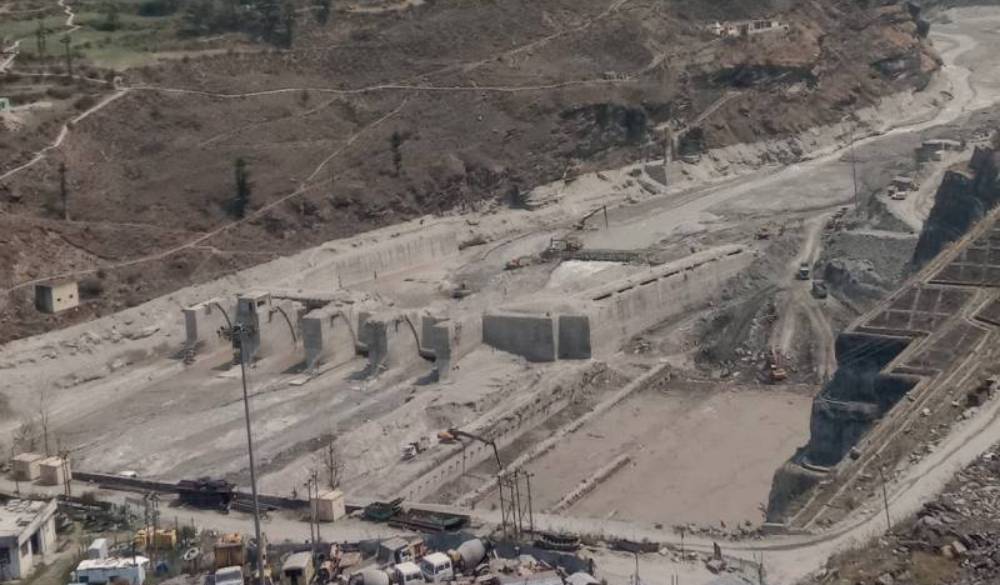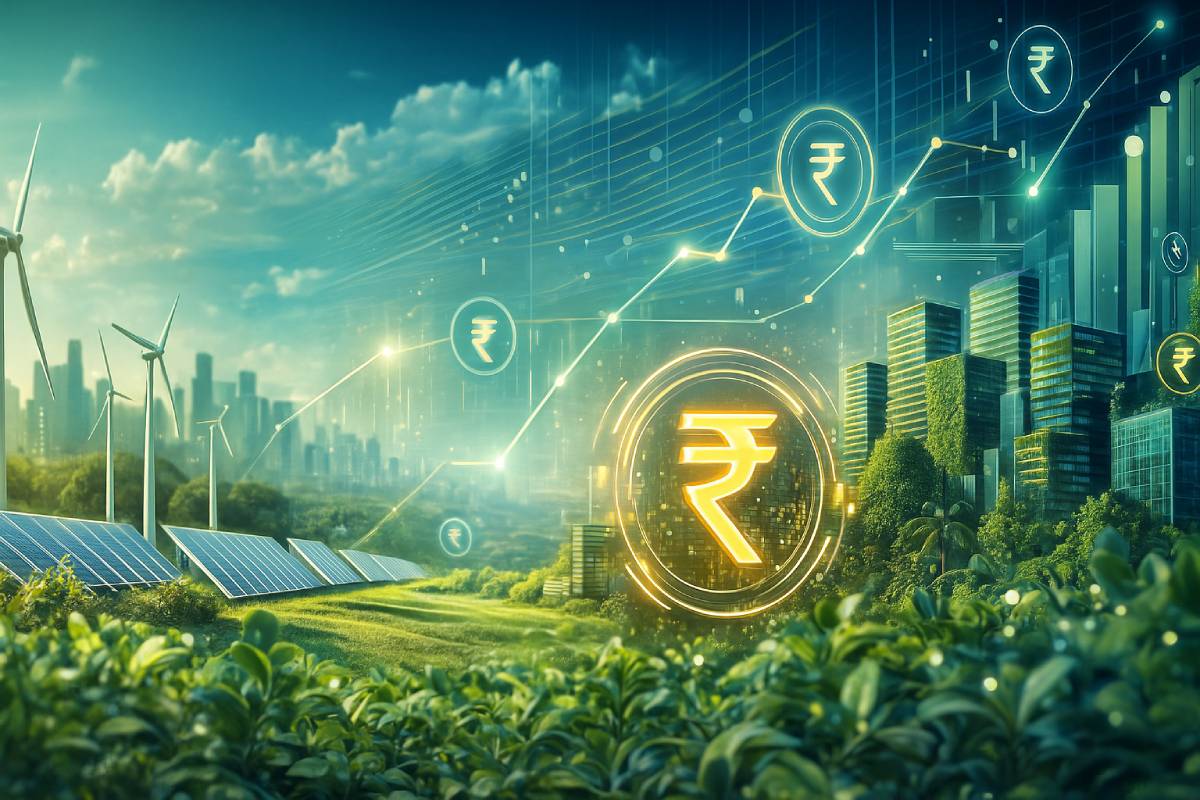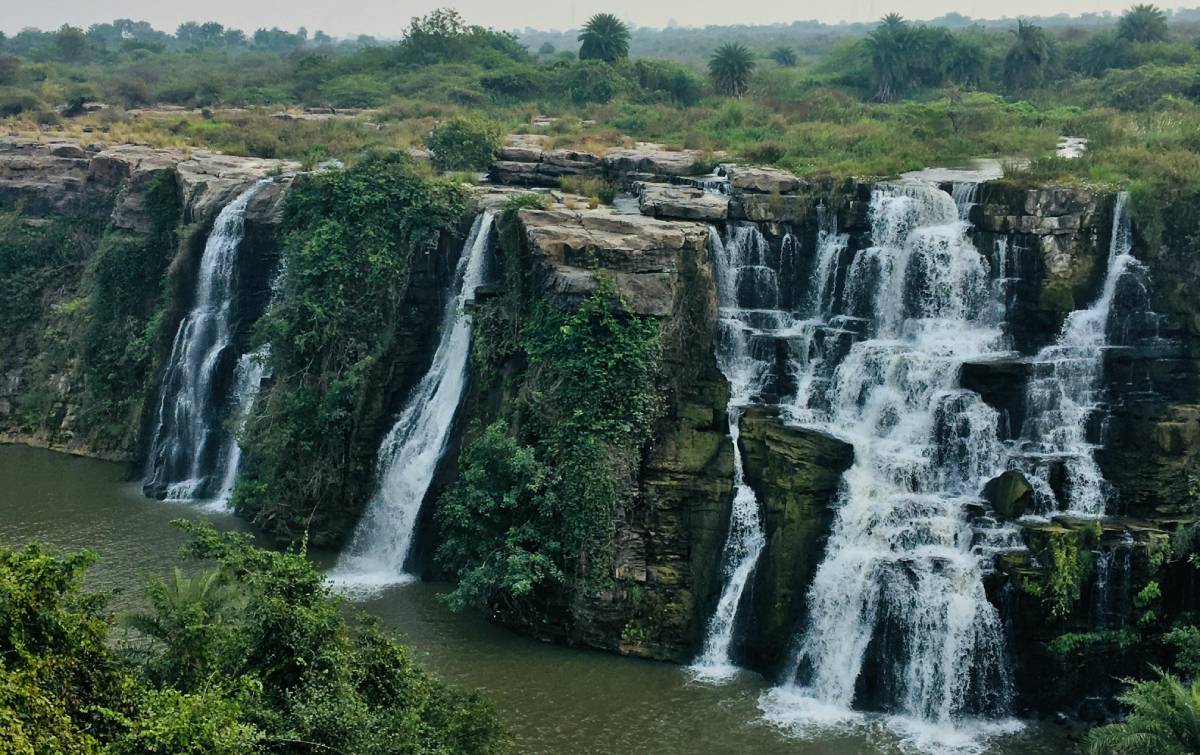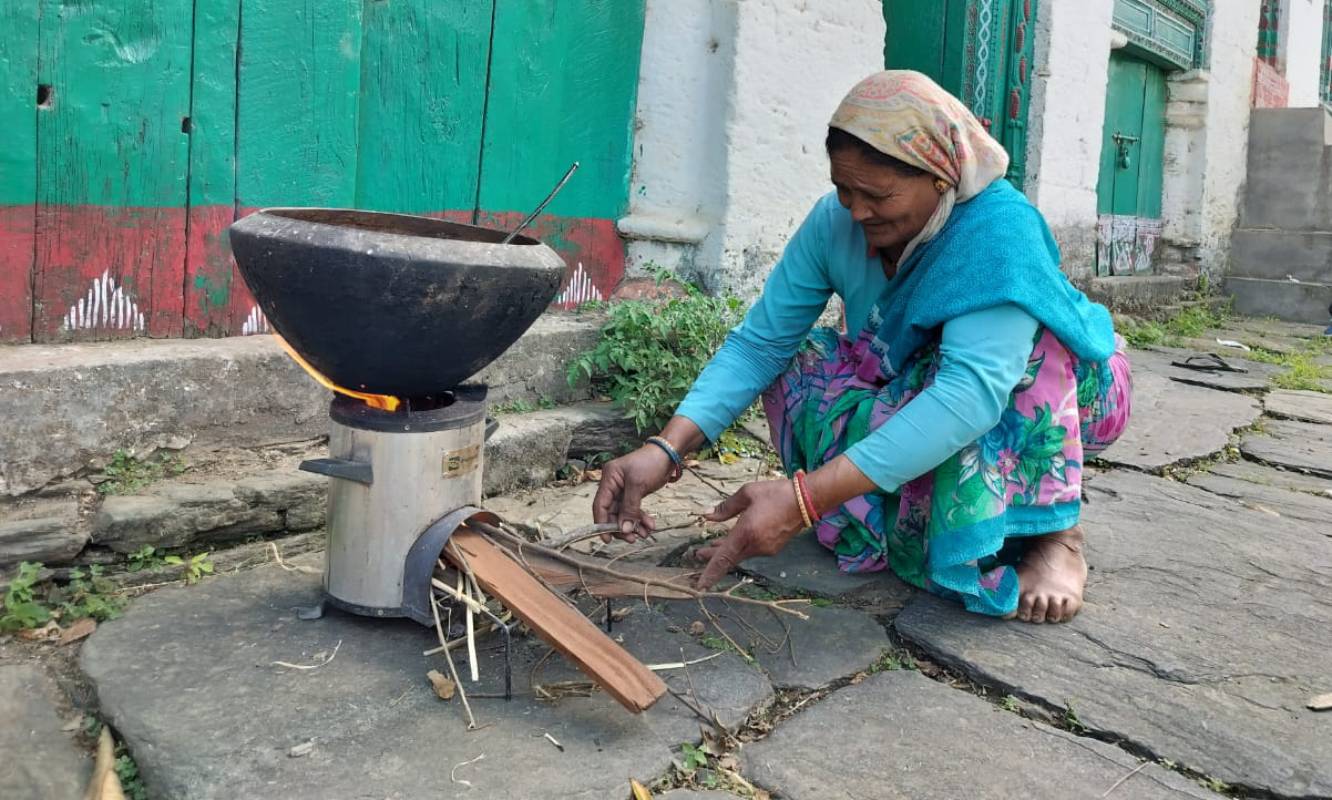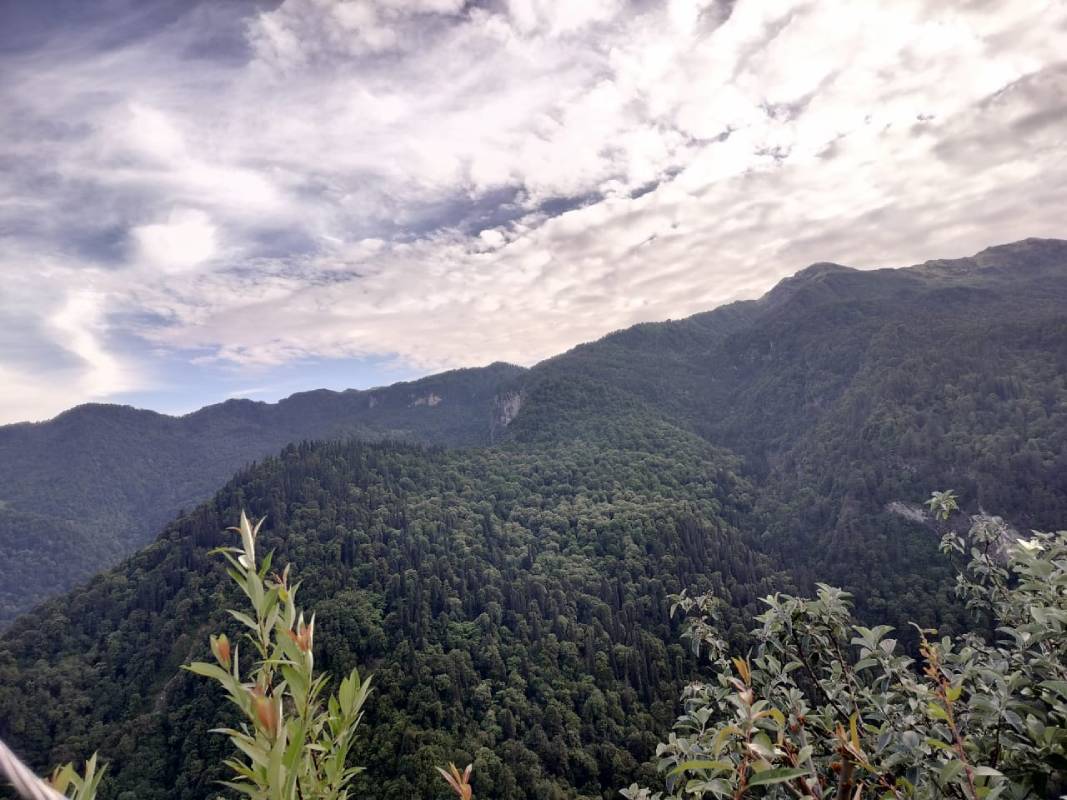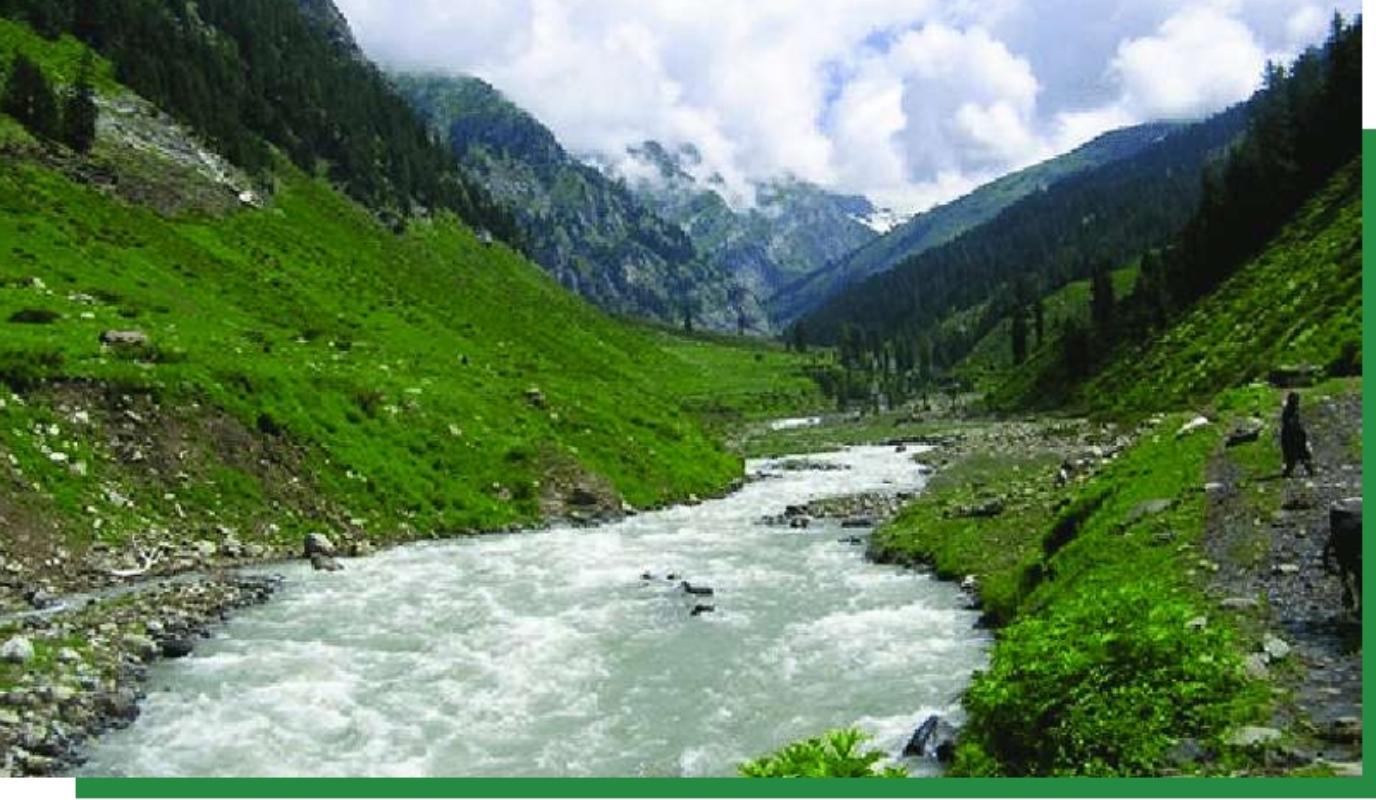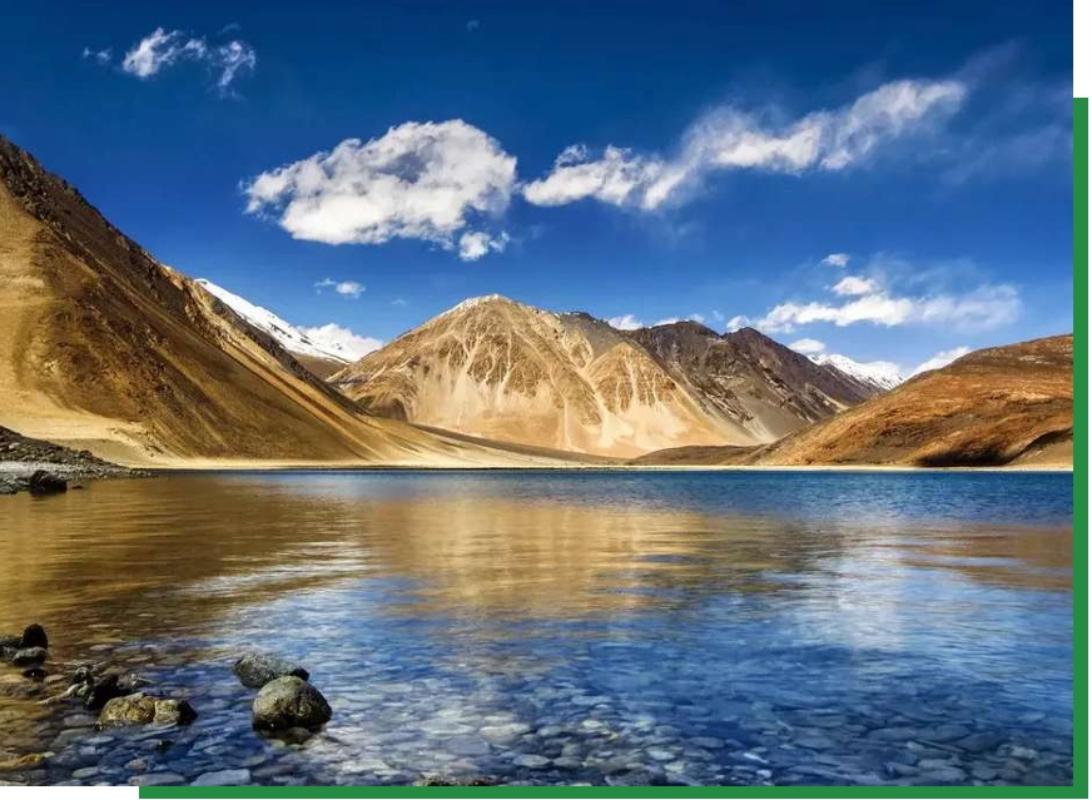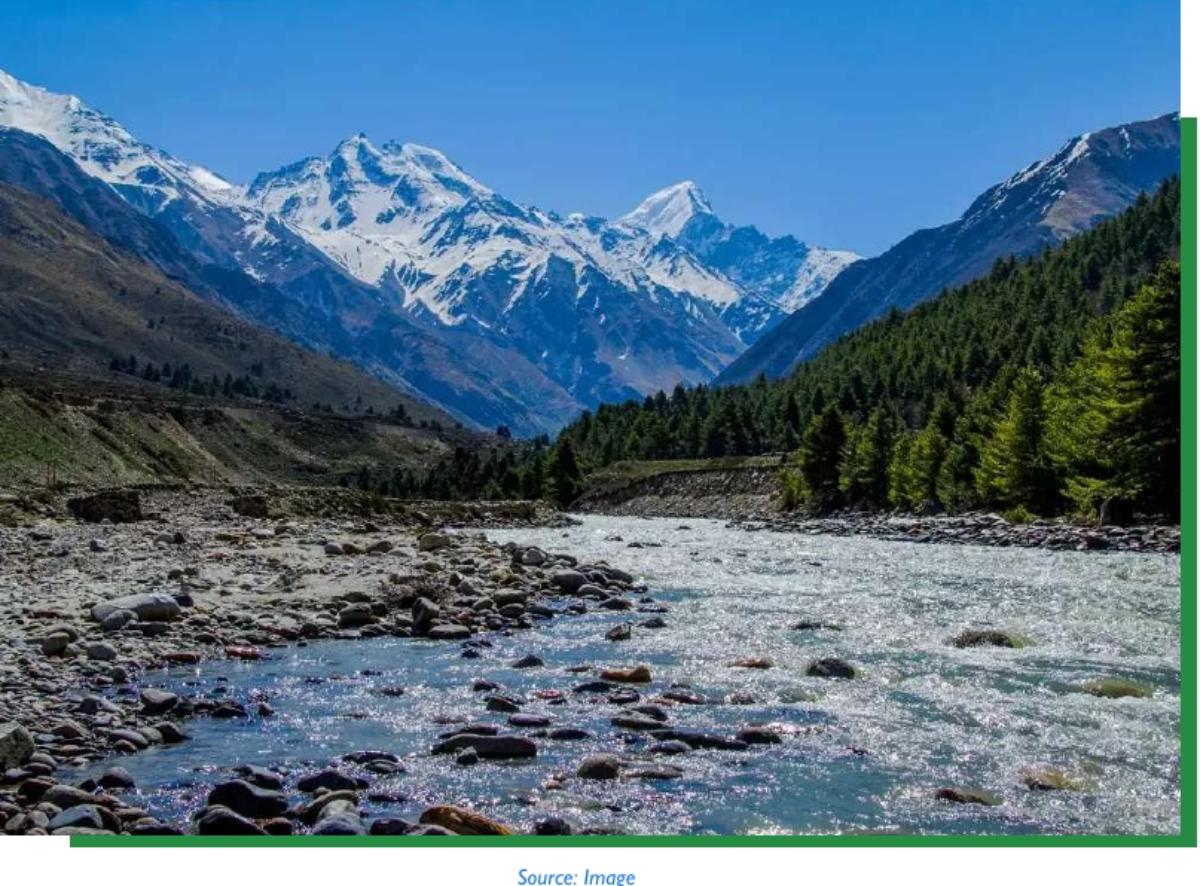The Nanda Devi Glacier Burst:
For a very short time, but the avalanche on February 7, 2021, in the Joshimath block of Chamoli district in Uttarakhand ignited the usually buried debate on the relevance of hundreds of hydro power projects being constructed in the state. This unexpected and non-seasonal avalanche took the lives of more than 200 workers at the site of two hydro power projects. Nearly 35 people were reported dead at the operational hydro power project ‘Rishiganga’ in the Reni Village. More than 175 workers reported dead at the Tapovan construction site of the Tapovan-Vishnugad hydro power project. This project is being constructed by the National Thermal Power Corporation (NTPC). The Rishiganga project was first hit by this avalanche resulting in the flash flood in the narrow valley of Rishiganga and Dhauli rivers. The then chief minister of Uttarakhand Mr. Trivendra Singh Rawat had said that this disaster is the result of climate change and has nothing to do with hydro power projects in the region. However, local people have many cultural, religious and ecological reasons to believe that the avalanche has connection to the construction of these two and other hydro power projects in the region. Unfortunately, the discussion on the benefits and losses of HEP in view of this disaster also died within a month from local to regional and national discourse. The event of glacier burst on that day followed by flash flood is a subject of scientific investigation, but this entire episode deserves a serious discussion on mushrooming of hydro power projects in these highly fragile Himalayan mountains and subsequent advantages and disadvantages.
| Hydro Power Projects in Dhauli and Rishiganga Sub-basin | ||||
| River Valley | Project | Estimated Potential (In MW) | Project Developer | Status |
|
Dhauliganga |
Tapovan Vishnugad | 520 | NTPC | Under Construction |
| Lata Tapovan | 171 | NTPC | Construction stayed by the Supreme Court | |
| Jhelam Tamak | 108 | THDC | Construction stayed by the Supreme Court | |
| Malari Jheam | 65 | THDC | Construction stayed by the Supreme Court | |
| Tamak Lata | 280 | UJVNL | Construction stayed by the Supreme Court | |
| Jummagad | 1.2 | UJVNL | Under Operation | |
|
Rishiganga |
Rishiganga-I | 70 | UJVNL | Construction stayed by the Supreme Court |
| Rishiganga-II | 35 | UJVNL | Construction stayed by the Supreme Court | |
| Rishiganga | 13.5 | IPP | Washed Away. Before the flash flood it was operational | |
Dhauli and Rishiganga are two small but important tributaries of Alaknanda river in Chamoli district. Both of these streams meet at Reni village. The village from where women started the renowned ‘Chipko’ Movement. In total these two streams have a stretch of around 60Km located in higher Himalayan altitudes in the state. The government has allowed nine hydro power projects on these two streams. Out of these, two are in operation, two are under construction and construction of five projects has been stopped by the Supreme Court on recommendation of a study carried out by Wildlife Institute of India (WII). A report of National Institute of Disaster Management (NIDM) in 2013 observed that mega projects including hydro power projects in Uttarakhand enhanced destruction manifold due to flash floods in the state in 2013. Nearly seven year after this important observation of NIDM, once again two power projects in the Rishiganga valley enhanced vulnerability from the natural disaster. For the loss of valuable human lives and social, economic and physiological traumatisation of hundreds of families due to this disaster can directly be attributed to the two hydro power projects in the region.
The NIDM report in 2013 had recommended a compulsory Disaster Impact Assessment (DIA) along with Environmental Impact Assessment (EIA) of all hydro power projects and other mega projects in the state[1]. Forget about previously planned developmental projects, we conveniently ignored this recommendation of NIDM for all projects planned and executed after the 2013 Uttarakhand disaster. So, the question is why hydro power projects in Uttarakhand enjoy strong political and industrial support despite successive disasters. This paper attempts to briefly analyze environmental, developmental and disaster related questions and concerns to indicate possible reasons for blind love of these projects.
The Questions of Environment
The expansion of hydro power projects in the state triggered environmental and livelihood issues. People affected from these projects protested across the state to register their concern. Many scientific studies have also observed that the construction of these projects have serious environmental consequences[2]. An audit of 48 power projects carried out by Comptroller and Auditor General (CAG) in 2009 reiterated concerns and questions raised by people, activists and scientific studies. The audit observed that there are serious inadequacies in pre-feasibility reports for these projects. Furthermore, the construction activities led to drying of river beds, unscientific muck disposal into the river and poor state of afforestation. It also observed that project developers are highly careless about environmental and safety issues[3].
The CAG in its audit in 2009 also raised concerns about EIA granted to the construction of hydro power projects and implementation of Environment Management Plan (EMP). With mushrooming of hydro power projects in the state, various people and authorities demanded cumulative EIA of hydro power projects being planned, constructed and operational in the state. On the request of the Ministry of Environment, Forest and Climate Change, the Wildlife Institute of India conducted a study to assess cumulative impacts of hydro power projects on aquatic and terrestrial biodiversity. The study carried out in Bhagirathi and Alaknanda basin of Uttarakhand observed as follows:
- 526.8km out of 1121km (47%) long stretch of rivers in these two basins is expected to be affected, if all proposed projects are implemented. It will lead to significant loss of or modification of fish habitat. This affects 66 fish species.
- The construction of dams in the region creates barriers for fish which move from one part of the stream to another.
- The diversion of water during and after construction of hydro power projects will adversely affect the entire aquatic biodiversity.
- The land use change of forest for the construction of a hydro power project significantly affecting terrestrial wildlife species. These projects have destroyed or fragmented a large area of habitat.
This study further recommended for review of 24 power projects planned in paraglacial zones threatening rare, endangered and threatened species of plants and wildlife. Similar observations were made by the expert committee constituted on the direction of the Supreme Court in 2013 to review the role of these mega projects in the 2013 flash flood in the Kedarnath valley of the state. The committee further raised issues related to unscientific muck dumping, deteriorating water quality, drying of springs and development of landslide zones in the large number[4]. The committee requested the court to stop construction of 24 projects planned in the para glacial zone of Alaknanda and Bhagirathi basins.

Source: https://cdn.downtoearth.org.in/dte/userfiles/images/hydroelectric_projects.pdf
Another study carried out by the IIT Roorkee commissioned by the Union Ministry of Environment and Forest observed that projects in these two sub basins are located in seismological zone-5 and geotract zone 1 and 2. These geological and seismological characteristics explain the fragility of the location. Moreover, the study observed that the region in these two sub basins is highly landslide prone. In its recommendation, the study had cautioned about projects in the geotract zone two and five.
Successive authoritative reports along with traditional ecological knowledge and academic exercises have found that the standalone and cumulative environmental impact of hydro power projects in the region are devastating and irreversible. They have significantly affected aquatic and terrestrial biodiversity. A large population of this region is dependent on natural resources including water, land and forest, so, degradation of these resources due to hydro power projects have also adversely affected their lives and livelihood.
The Fear of Disaster
There were always questions on the disaster impact of a large number of hydro power projects being planned and constructed in Uttarakhand. These questions were pertinent because a large part of the state is situated in seismic zone 5 and 4. These zones are highly vulnerable to devastating earthquakes. Moreover, the fragility of Himalayan range is also not hidden. The state disaster management plan of Uttarakhand recognizes frequent incidents of disasters such as earthquakes, landslides and flash floods. Mega infrastructure projects in this highly vulnerable region can enhance vulnerability of people, infrastructure and natural wealth available in the region. The flash flood of 2013 in Uttarakhand, which took the lives of more than five thousand people instigated a systematic evaluation of the role of various hydro power projects in the natural disaster.
| Summary of Damages and Estimates of Reconstruction Cost after 2013 disaster | ||
| Sector | Damage | Cost (Rs. In Millions) |
| Housing | 3077 units | 1505 |
| Public Buildings | 995 units | 1029 |
| Roads and Bridges | 2174 Roads, 85 motor bridges and 140 Bridle bridges | 27103 |
| Urban Infrastructure (Water Supply, roads, Drains and Sewerage) | 41 towns | 1268 |
| Rural (Water supply and Sanitation) | 8728 habitations | 1305 |
| Livelihood (Agriculture, Livestock, Fisheries, tourism linked livelihoods, Micro enterprises and other | 83,320 HH affected | 1668 |
| Irrigation | 1393 | |
| Tourism Infrastructure | 1166 | |
| Energy/Power | 17 HEP projects | 2662 |
| Forests and Biodiversity | 542 | |
| Total | 39641 | |
https://www.adb.org/sites/default/files/linked-documents/47229-001-sd-01.pdf
On the direction of the Supreme Court the Union Ministry of Environment, Forest and Climate Change constituted an expert committee to evaluate the role of hydro power projects in the 2013 flash flood in Uttarakhand. The committee in its final report observed that despite, located in a highly disaster prone region, no hydro power projects visited by the committee have any mechanism and readiness to handle emergencies like flash floods. The report further concluded as follows[5]:
(i) Sediments created huge destruction in the flash flood and in the lower catchment of Mandakini and Alaknanda valley sediments were locally generated by a mechanism other than land sliding.
(ii) Downstream of the Mandakini valley the sediment bulking is caused by a combination of muck and collapse of unconsolidated river banks. It further led to migration of the Mandakini river channel under hyperconcentrated flow.
(iii) The sringal hydro power project further down in the Mandakini and Alaknanda catchment, the Srinagar hydropower project failed to retain the muck which got washed into the river and assisted in aggravating the damage in the lower reaches of Sringar town.
(iv) A significant contribution to the flood sediment was made locally available by much disposal.
(v) The maximum destruction of land and property occurred in areas downstream of hydro power projects at Singoli-Bhatwari, Vishnuprayag and Srinagar hydro power projects.
The India Disaster Report 2013 published by National Institute of Disaster Management in report commented that the flash flood in June 2013 in Uttarakhand is the result of heavy rain. It further clarifies that historically such incidents of flash flood are common in Uttarakhand. The lesson it drew from the disaster is that the vulnerability was enhanced manifold by anthropogenic activities in the region. It further recommends as follows[6]:
- Flood Plain Zoning Act regulating construction within the flood plain of a river should be implemented strictly.
- For clearance of all hydro-power and other mega projects in ecologically sensitive regions like Uttarakhand, the Disaster Impact Assessment (DIA) should also be made compulsory besides Environmental Impact Assessment (EIA).
The National Green Tribunal (NGT) summarizes the state of anthropogenic enhancement of disaster vulnerability in the state in one of its judgments on 26th August 2013. The Tribunal observed that the indiscriminate construction and establishment of hydro power projects in Uttarakhand aggravated social, economic and ecological loss due to natural disaster[7]. It is further held responsible to governments and authorities for not performing their statutory function and constitutional duty of protecting ecology and environment.
The Promises of Development
The government of India through its policy on generation of hydro electric power aims to increase power generation by tapping hydro electric potential available in the country. Along with low cost of power generation, it is expected to reduce India’s dependency on fossils for energy. The Uttarakhand government in 2002 released state policy on hydro power generation in accordance with the national policy. After the formation of Uttarakhand state in 2000, high emphasis was given for the hydro power sector. By harnessing the hydro power potential of the state, Uttarakhand aimed to contribute significantly in the country’s power generation and open development prospects for its own remote areas[8]. While different state policies on generation of hydro power expressed the vision of tapping hydro electric potential, the successive state governments claimed that it will bring additional three distinct major benefits to the people of the state. These are- 1) making Uttarakhand an energy surplus state, 2) Substantial enhancement in state revenue by sale of electricity and royalty and 3) New job opportunities for local people. This section briefly analyzes the status of these three stated benefits to the people of Uttarakhand.
The Promise of Energy Surplus State
The government of Uttarakhand has estimated that the hydro resources available in the state have annual potential to generate 24551MW electricity. However, as of today 37 hydro power projects operated by different agencies (both government and private) have potential to generate only 3,791 MW energy in a year. However, Uttarakhand does not get all of this. A significant part of the generated power by different CPSUs feeds in the national grid. Moreover, 87 different hydro power projects are in the different stages of construction and planning. These projects, if completed, have potential to generate another 9,885 MW of hydro energy in the state. In this list, 33 projects are being allotted to private sector power producers. UJVNL and Central Public Sector Units (CPSUs) are allocated 32 and 22 projects respectively. Many projects of potential to annually generate 3,959 MW energy have been stalled by the central government and courts on account of irreversible ecological damage by these projects. So, out of its ambitious target to tap nearly 25 thousand megawatt hydro energy, Uttarakhand could only identify and process projects of potential to generate around 16 thousand megawatt hydro energy. More importantly 20 years after the formation of the new state, the current hydro energy potential tapped is only 3,791 MW.
Uttarakhand Power Generation Capacity (2015)
| Source | Latest Firm Entitlement (in MW) |
| Own Generating Station (OGS) | 1167.66 |
| Private Generating Station (PGS) | 267.90 |
| Central Generating Stations (CGS) | 928.12 |
| Grand Total | 2363.68 |
http://www.powerforall.co.in/AccessFolder/PFA_Document/1_UTTARAKHAND_PFA.pdf
An agreement between Union Ministry of Power and State government to assure power for all signed in 2015 reveals that the state had capacity to generate 2361.08MW energy in a year. State owned power generation stations (mainly hydro electricity) had contributed 50% of the total installed capacity in 2015. However, the production from state owned generation stations was only 31% of the total energy demand of the state. It was purchasing 26% of total power consumption from outside the state. The state was expected to substantially increase its installed capacity by commissioning of various hydro power projects by 2019. It aimed to increase annual power generation capacity by 145 MW through state and IPP owned eight hydro projects. It had further expected to add power generation capacity by 395 MW through commissioning of four hydro projects being developed by CPSUs. However, five year down the line none of these projects could be completed. The installed capacity of the state remained the same. According to the Economic Survey of Uttarakhand 2020-21, the state is dependent on external sources for around 50% of its electricity demand.
The latest data on installed capacity of power generation stations owned by private and centrally owned stations is not available. However, the latest economic survey of Uttarakhand (2020-21) reveals that the installation capacity of the state’s own station has not increased in the last ten year[9]. The above analysis reveals that the state is still a power deficient state despite hue and cry for about two decades.
The Expectation of Revenue Receipt:
The state policy on hydro power projects developed by the private sector has granted various incentives including waiving royalty fee in certain cases. Yet, all these projects are expected to help in generating non-tax revenue of the state. Currently, there are 18 hydro power plants commissioned by individual power producers (IPP). These projects have installed capacity of 881.65 MW. In various river valleys 33 more projects are in the different stages of construction owned by IPPs. These projects are expected to add another 1360 MW in the total power generation capacity of the state.
The state government earns non-tax revenue from the power sector by selling electricity and levying royalty and cess from individual power producers. Budget estimates and actual expenditure of the state government for the last few years suggests that non-tax revenue contributes marginally in the total receipt of the government. Further, the electricity sector is the third largest non-tax revenue source after forestry and mining.
Revenue Generation from Power (Sale, Royalty, Cess and Power Transmission)
| Year | 2021-22 | 2020-21 | 2019-20 | 2018-19 | 2017-18 | 2016-17 |
| Estimated | 500 | 500 | 440 | 400 | 300 | 130 |
| Actual | 11.1 (RE) | 3 | 186.6 | 286.2 | 351.3 | |
| Share of hydro power in total revenue (2021-22 BE) = 2.21% |
Source: Compiled from State Budget (Uttarakhand)
The ‘urja pradesh’ Uttarakhand so far has been unable to generate any significant revenue from hydro power projects. Of the total revenue generated, most of it comes from the sale of electricity through the DISCOM for household and commercial consumption.
The Hope of Job Creation
The state government believes that the royalty levied from individual power producers will help in carrying out social and developmental activities in the state. The analysis above reveals that so far in the last two decades, it remained a dream as the revenue generation through royalty and cess is significantly low. It was also estimated that 10% the investment on hydro power projects by developers would go to different social, economic and developmental activities. However, the IIT Roorkee in one of its reports flagged that such estimation needs to be studied in detail[10].
Local job creation and reducing distress migration for livelihood was one of the main benefits listed by people and policy makers in favour of hydro power projects in the state. But a closer look at the state of employment and migration reveals that the situation has not improved after the formation of the state in 2000. According to an estimate of the State Migration Commission, people are continuing to migrate from villages of the state in search of jobs. The report reveals that 50% people are migrating in search of livelihood[11]. It further found that in many mountain districts hundreds of villages have been deserted after 2011.
Reasons of Migration from Villages in Uttarakhand
| Reason for migration | %age of people migrated |
| In search of livelihood/employment | 50.6 |
| Due of unavailability of health services | 8.83 |
| Due to unavailability of education services | 15.21 |
| Due to unavailability of infrastructure (road, electricity, water etc) | 3.74 |
| Due to decrease in agricultural productivity | 5.44 |
| Other | 16.61 |
http://www.uttarakhandpalayanayog.com/pdf/English%20version.pdf
Despite all these ground realities, the Economic Survey Report of the state for 2020-21 claims that hydro power projects are effective in providing employment for local youth. In contrast a study carried out by the World Bank found that employment generation through hydro power project is not actually true. The report reads, “Provision of employment is often cited as one of the primary social benefits of HEP projects; however, it must be recognized that most of the employment is often construction related and therefore temporary. The literature recognizes that one should not overstate the contribution of HEP employment creation[12].” It is true that few people from project sites do get short term employment, contractual jobs and micro contracts in the process of project construction. After the construction, no project can retain even those few workers, vendors and contractors.
So, Who Benefits from HEP?
Many activists who were part of the Uttarakhand movement believe that the movement did not deliberate on the vision of the state in terms of economic, social, cultural, geographical and geological perspective. After the formation of the state, this crucial task automatically transferred to the politicians, people representatives and state government of the newly formed state. The idea of ‘Urja Pradesh’ emerged from this necessity. Within a few years of formation of the state, the government developed its policies to tap hydro electric potential available in the state. Soon many public and private investors were invited to set up hydro power generation stations in the state. This idea of ‘Urja Pradesh’ was supported and promoted by successive state governments.
Initially the idea of Urja Pradesh also succeeded in effectively responding to public sentiment which believed that pahaar ka pani aur jawani, dono pahar ke kaam nahi aata (neither water nor young workforce of the mountains are tapped to develop the region). However, as the plan rolled out, people started realizing devastating and irreversible social, economic, ecological and cultural damages due to more than hundred power projects being planned and constructed in the mountains.
Two decades after the formation of Uttarakhand, the idea of developing the state’s economy around hydro power projects seems to have fallen apart. This idea has not benefited common people and the government in any sense; be it is employment, electricity generation or revenue to the government. Moreover, the construction of many of these projects has badly disturbed regional ecology, wildlife, geology and hydrology. This damage has further affected the lives and livelihood of the local people.
The aggregation of disaster vulnerability due to several hydro power projects is yet another imported problem under the broad idea of Urja Pradesh. As per the government’s own estimate, the flash flood of 2013 cost loss of property worth 40 thousand million rupees. This cost is way higher than total investment attracted so far by the state to develop power projects. Remember, that the various reports found that hydro power projects in Mandakini and Alaknanda valley aggregated the damage. The human lives lost on 7th February 2021 due to flash flood in Rishiganga valley is yet another major incident where hydro power projects aggregated the disaster vulnerability.
The slogan of Urja Pradesh may have helped people in Uttarakhand to feel proud about the newly formed state and its vision. It may also have provided employment to a few thousand people and improved their family income. It may have also helped the state to represent itself in various national and international business forums. But, it is very clear that the slogan of Urja Pradesh did not help people in large. It failed in delivering on its own promises.
Footnotes:
[1] https://nidm.gov.in/PDF/pubs/India%20Disaster%20Report%202013.pdf
[2] https://www.jstor.org/stable/23528499?seq=2#metadata_info_tab_contents
[3] http://iced.cag.gov.in/wp-content/uploads/2014/02/1.-Environment-impact-of-HPP-in-Uttrakhand.pdf
[4] http://gbpihedenvis.nic.in/PDFs/Disaster%20Data/Reports/Assessment_of_Environmental_Degradation.pdf
[5] http://gbpihedenvis.nic.in/PDFs/Disaster%20Data/Reports/Assessment_of_Environmental_Degradation.pdf
[6] https://nidm.gov.in/PDF/pubs/India%20Disaster%20Report%202013.pdf
[7] http://www.indiaenvironmentportal.org.in/files/Uttarakhand%20NGT%2026Aug2013.pdf
[8] https://www.iitr.ac.in/wfw/web_ua_water_for_welfare/power/25_MW_Plus_Policy_of_Uttaranchal.pdf
[9] https://des.uk.gov.in/files/Economic_Survey_2020-21_-_(Ch_10-17).pdf
[10] IIT Roorkee, AHEC/2011: Assessment of Cumulative Impact of Hydropower Projects in Alaknanda and Bhagirathi Basins
[11] http://www.uttarakhandpalayanayog.com/pdf/English%20version.pdf
[12] http://documents1.worldbank.org/curated/en/406951468326991910/pdf/702810ESW0P1100tBenefits0Lit0Review.pdf

